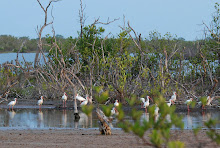The mangroves and coastal lagoons of Belize are arguably the most productive and important ecosystem for the continuing health of the marine coastal zone. Belize has one of the largest mangrove lagoon systems in the Americas.
While the biodiversity of the mangrove habitat is relatively low when compared to the broadleaf forest, it is the biological processes the mangrove facilitate that define its importance. The flow of water drops its sediment load on the bacteria rich bottom. The bacteria transform the nutrients into food in the form of their bodies, which are fed upon by microscopic invertebrates, which are in turn ingested by macro invertebrates like crabs, shrimps and larvae fish. The process continues on up the food chain to the top predators - tarpon, snook, egrets, reptiles, small mammals and manatee.
The structure of roots, detritus and leaves form the perfect substrate to hide the young of most sea creatures, making the mangrove habitat the nurseries of the sea.
There are four mangrove species in Belize, all partitioning the mangrove habitat according to their biological needs. The red mangrove (Rhizophora mangle) is the pioneer species which can tolerate salt water better than any other mangrove. It's stilt roots are usually found half submerged along most of the shoreline of Belize. Immediately behind the red mangrove grows a zone of black mangrove (Avicennia germinans). The black mangrove is the true transition plant between land and water. The distinguishing characteristic of the black mangrove are the pencil thin root extensions called pneumatophores which rise out of the anoxic mud. They often form thick mats at the base of the trunk and are used to take in oxygen. Further inland grow the white mangrove (Laguncularia racemosa) and the buttonwood (Conocarpus erecta) which is not a true mangrove, but a common associate of mangrove swamps.
Friday, September 3, 2010
Subscribe to:
Post Comments (Atom)









No comments:
Post a Comment